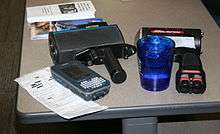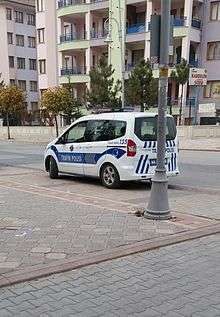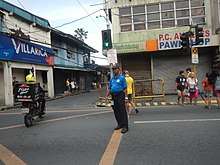Traffic police
Traffic police or traffic officers,[1] often referred to colloquially as traffic cops or traffic enforcers, are police officers who direct traffic or serve in a traffic or roads policing unit enforcing rules of the road. Traffic police include officers who patrol major roads and also police who address traffic infractions on other roads. It has been noted that:
...traffic police, who are regarded as peripheral to most police forces, participate in both authoritative intervention and symbolic justice. Perhaps alone of all the assignments, traffic police are full-service police. They are different from the rest, however, because their work is limited to a particular venue — namely, public thoroughfares — and to particular people — namely, those who operate motor vehicles. But in terms of work, traffic police are detectives as well as patrol officers.[2]





_1.jpg)

History
Traffic police have existed in some form for nearly three centuries:
Road traffic began to increase in volume and speed during the eighteenth century, and the above mix of practices led to a clear need for some legal rule-making. In response, in 1722 the lord mayor of London appointed three men to ensure that traffic kept to the left and did not stop on London Bridge. They were possibly the world's first traffic police.[3]
Automatic traffic police
In the Democratic Republic of the Congo five automatic traffic police are in operation.[4] The large aluminium figures are able to rotate at the waist, and contain closed circuit television cameras to allow them to record offenders, for later apprehension or imposition of fines. The system runs on solar power, from panels on the roof of the structure within which the robot stands. The robot controls the traffic with red and green lights in its hands, and the use of articulated arms. The robots can also speak to pedestrians and help them safely cross the road.[5]
The system is designed and built by a women's engineering co-operative in DRC. Another five robots have been bought for Katanga province, and a further thirty for motorway use have been proposed.
Examples of traffic police departments
- Turkish Traffic Police, Turkey
- Bangalore City Traffic Police, India
- Kolkata Traffic Police, India
- Traffic Police Corps, Indonesia
- Mumbai Traffic Police, India
- National Traffic Police, Israel
- Islamabad Traffic Police, Pakistan
- Main Directorate for Road Traffic Safety (GAI), Russia
- Traffic Police, Sri Lanka
- Road Policing Units, United Kingdom
- Philippine National Police Highway Patrol Group, Philippines
Traffic officers who are not sworn police officers
- Highways Agency Traffic Officers, England
- Welsh Government Traffic Officers
- Dartford Crossing Traffic Officers, England
- Land Transportation Office Law Enforcement Service
- Metropolitan Manila Development Authority Traffic Discipline Office
Traffic policing as a model
In 1998 Stephen Chance and Stephen Dale proposed traffic policing as a model to deal with paperwork.[6]
See also
- Highway patrol
- Traffic Cops, a BBC real-life documentary
- Parking enforcement officer
- Traffic guard, a person who directs traffic through a construction site or other temporary traffic control zone
- Crossing guard
- Bylaw enforcement officer
- Rules of the road
- River police
References
- United States Department of Transportation, National Highway Traffic Safety Administration, National Committee on Uniform Traffic Laws and Ordinances, Traffic Laws Annotated 1979 (1981), p. 17.
- David H. Bayley, Police for the Future (1996), p. 34.
- M. G. Lay, Ways of the World: A History of the World's Roads and of the Vehicles That Used Them (1992), p. 199.
- "Robocops being used as traffic police in Democratic Republic of Congo". Guardian. 5 March 2015.
- "Robot traffic wardens patrol Democratic Republic of Congo". Irish Examiner. 6 March 2015.
- Stephen Chance, Stephen Dale (1998). Getting to grips with paperwork: a model drawn from traffic policing. Police Research Series. Issue 25. Great Britain: Home Office Police Research Group. ISBN 9781840820485.